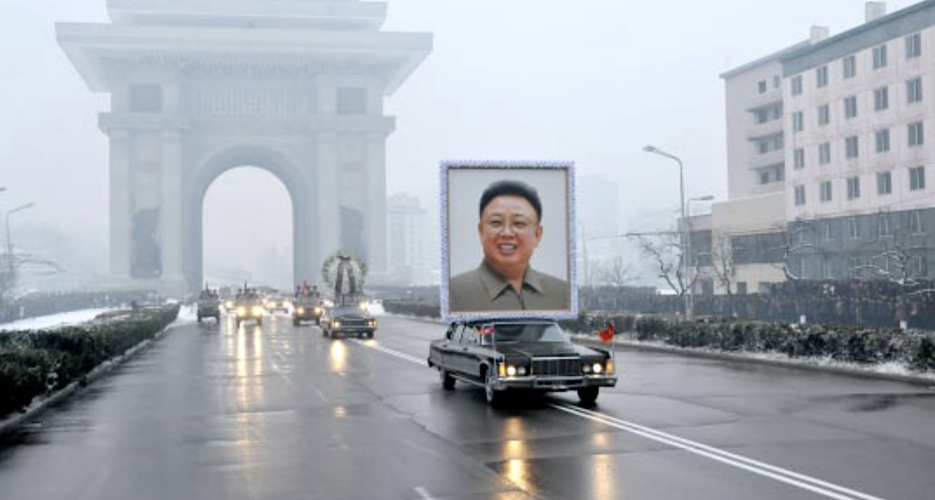NEWS
BREAKING NEWS: Public reaction to Kim jong ll and How Kim Jong Il’s death threw the North Korea tourism industry into flux

How Kim Jong Il’s death threw the North Korea tourism industry into flux
Even local guides didn’t seem to know what would happen as the country mourned leader’s passing 11 years ago this month
Gareth Johnson December 21, 2022
How Kim Jong Il’s death threw the North Korea tourism industry into flux
An oversized portrait of Kim Jong Il during the former North Korean leader’s funeral procession on Dec. 28, 2011
The following article is part of a series by Gareth Johnson of Young Pioneer Tours about being a North Korea tour guide. Views expressed in columns are exclusively the author’s own and do not represent those of NK News.
North Korea marked the 11th anniversary of Kim Jong Il’s death over the weekend, and while the country has long since moved on, the former’s leader passing was a momentous occasion for both the DPRK and the wider world. For everyone, it created uncertainty and insecurity, not least for us in the North Korea tour industry.
I was in London for Christmas when it happened, throwing us into flux. While we are now no strangers to North Korea closing to tourism during the pandemic, Kim’s passing on Dec. 17, 2011 was completely different. We genuinely did not know what would happen.
One of the primary concerns was how long the mourning period would be. We had booked guests through to April, with big groups for the Kim Jong Il birthday tour that would include the Kimjongilia flower display and a general celebration of his life in mid-February. Spring is generally a popular time to travel to both Koreas, owing to fair weather.
And it was not even a question we felt we could broach with our North Korean business partners until after the funeral, which was finally held on Dec 28. During this interlude, we hypothesized about what might happen. Our only point of reference was the period of mourning for President Kim Il Sung, which officially lasted three years and made it difficult for tourists to enter the country.
To our surprise and relief, we learned in late January that the country would be open fully from Feb. 1 and indeed our tours could go on as normal. We ourselves sent a small group in early February ahead of what would have been Kim Jong Il’s 71st birthday, and this turned into one of the most surreal times we’ve ever spent in North Korea.
Even though the entire country was in a state of mourning, the birthday celebrations for Kim Jong Il remained almost unchanged from what we saw in past years.
Our travel itinerary was almost the same as it would have been for any other birthday tour, and most North Koreans we spoke to still referred to Kim in the present tense. Our personal guides and friends in the country seemed genuinely morose and abstained from drinking. They said the country had experienced a tragedy, and repeated the state media claim that Kim died while working for the country.
However, in terms of before and after, our regular tour itinerary remained largely unchanged. Our guides did not go out of their way to remind us of the death of Kim Jong Il, nor did they add in requisite stops or activities as a result of his passing. The North Koreans in the country, however, seemed to abstain from certain locations such as parks, zoos and amusement parks.
Through this sadness, there was also a very strong sense of uncertainty. Kim Jong Il had been in some sort of power since at least the 1970s and in total control since 1994, providing a certain level of stability and cohesiveness even as the country dealt with the end of the Cold War, the death of Kim’s father Kim Il Sung, the Arduous March famine and other turbulence.
And as for the new leader Kim Jong Un, our North Korean contacts had very little to say about him other than referring to him as the new leader. I personally remember being in the Koryo Hotel when he first appeared on Korean Central Television (KCTV) in late 2010.
Kim Jong Un receives applause at the Eighth Party Congress in Jan. 2021 | Image: Rodong Sinmun (Jan. 13. 2021)
Although state media had not previously telegraphed that he was Kim Jong Il’s heir apparent or even his son, the North Koreans around me at the Koryo Hotel bar seemed to understand the significance of who and what they were seeing on the screen. They seemed legitimately excited to see who their next leader would be.
So while people knew who was to follow when Kim Jong Il died a little over a year later, North Koreans knew very little about Kim Jong Un, and certainly in those first few trips under his leadership, they spoke very little about him.
We were able to continue tours throughout 2011, and it appeared that Kim Jong Il’s death drove renewed interest in the country, evidenced by more people than ever reaching out to us to arrange visits. Soon, we saw more people wearing badges featuring both Kim Il Sung and Kim Jong Il, and statues of Kim Jong Il began to appear at requisite tourist attractions such as Mansu Hill.
The transition to the new leadership, however, was far less immediately apparent on the ground. It probably took at least a few years before the baton had truly been handed over.












